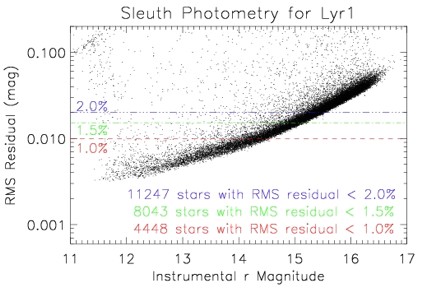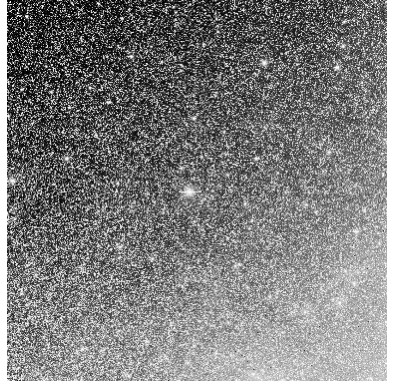Summary details for TrES Lyr1 Exoplanet Archive-ETSS Data Sets
Telescope
The 10-cm Sleuth telescope (Palomar Observatory, California) and the 10-cm Planet Search Survey Telescope (PSST; Lowell Observatory, Arizona).
Instruments
The PSST detector is a thinned, back-illuminated 2048x2048 Loral CCD with 15-micron pixels (Dunham et al. 2004). The Sleuth detector is a Marconi 2048x2048 13.5-micron-pixel back-illuminated CCD camera.
Observed Region
The two telescopes monitored a 5.7° x 5.7° field of view centered on the star 16 Lyr (19h 01m 26.3713s +46d 56m 05.325s).
Observed Filters
Sleuth utilitizes an SDSS r filter, whereas PSST uses a Johnson R filter. The integration times for our exposures were 90s.
Photometric Technique
Standard IRAF tasks or customized IDL routines were used to calibrate the images from the two telescopes. Differential image analysis was applied to each of the separate photometric data sets using a pipeline based in part on Alard (2000). The two data sets were then combined by matching the stars in each field of view. Transit detection was performed using the box-fitting transit search algorithm of Kovacs et al. (2002).
Data Ranges
The data parameters fall into the following approximate ranges:
| Field | Min | Max |
|---|---|---|
| RA (2000) | 18 43 1.8 | 19 19 30.8 |
| Dec (2000) | +43 54 23.0 | +50 00 00.0 |
| HJD of the observation |
2453541.788 | 2453616.734 |
| Instrumental B magnitude |
8.33 | 14.49 |
| Instrumental V magnitude |
8.11 | 12.47 |
| Instrumental R magnitude |
9.25 | 16.53 |
| Total number of stars | - | 25947 |
| Number of epochs | - | ~15000 |
Figures and Images

Figure 1: Calculated rms residual of the binned data vs. instrumental r magnitude for the stars in the Sleuth Lyr1 data set. The number of stars with rms below 1%, 1.5%, and 2% are shown.

Figure 2: Image of the TrES-Lyr1 Field, centered almost exactly on 16 Lyr (bright star in the middle of the image). The field of view is 5.7° on the side.
Download Data Sets
| TrES Lyr1 summary file | IPAC ASCII format table |
| TrES Lyr1 light curves | Download scripts |
Primary References
- "TrES-2: The First Transiting Planet in the Kepler Field", O'Donovan, F. T., et al. 2006, ApJ, 651, L61
- "PSST: The Planet Search Survey Telescope", Dunham, E. W., Mandushev, G. I., Taylor, B.W. and Oetiker, B. 2004, PASP, 116, 1072
- "Rejecting Astrophysical False Positives from the TrES Transiting Planet Survey: The Example of GSC 03885-00829", O'Donovan, F. T., et al. 2006, ApJ, 644, 1237
- "Outcome of Six Candidate Transiting Planets from a TrES Field in Andromeda", O'Donovan, F. T., et al. 2007, ApJ, 662, 658




